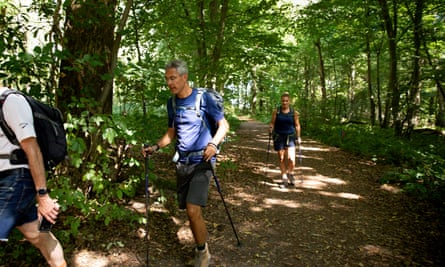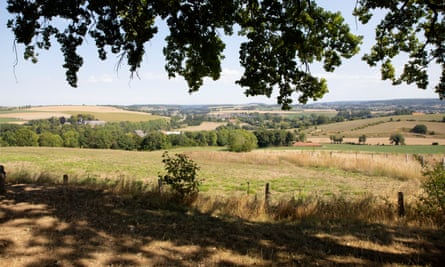The Netherlands, so the guidebook notes, has been “popularised as a flat land full of cheese and clogs”.
Enthusiasts behind the Dutch Mountain Trail, a 63-mile (101km) hike across seven glorious peaks – two of which are made from the spoil of old mines – merely ask, only a little tongue in cheek, that the world stops being so narrow minded.
Emerging from a local branch of an annual festival celebrating mountain films and culture across the globe, the “alpine” walk in the lowlands was first thought up in 2020 as the climate consequences of travel became ever-clearer and Covid made it difficult to get to the more traditional European summits.
“That means not flying all over the world to chase your big mountains but also to look in your backyard,” said Toon Hezemans, 60, one of the creators of the trail in South Limburg, the southernmost region of the Netherlands, jutting into Belgium and Germany.
A route was devised and word of mouth did the rest. It was an immediate success. An estimated 17,000 Dutch and German copies of a guide to the hike have been sold so far. This November, an English-language version will be published.
As to the potential issue of the lack of actual mountains in Europe’s flattest country, Hezemans, an artist by profession, questioned the very definition. “That’s a very interesting one,” he said, mentioning a Hugh Grant comedy, The Englishman Who Went Up a Hill, But Came Down a Mountain.
In the movie, Welsh villagers are furious when English cartographers declare that their “mountain” is in fact a hill as it doesn’t meet the 1,000ft (305 metres) threshold. The locals build a mound on top of the summit to cheat the system.

For Hezemans and Andrew Davies, 65, his conspirator and the translator of the guidebook into English, that is not what a mountain is about. “I don’t think you ought to take 1,000ft as a definition because the word in Dutch is berg, which has a slightly different definition,” said Davies, who moved to the Netherlands from Manchester 38 years ago.
“It depends on the surrounding,” insisted Hezemans, while overlooking the scenic valleys from a bench on the Eyserberg, a peak about 200 metres above sea level. “This one in the Himalayas won’t be a mountain. But you can see the church steeple of the Vijlen, they call themselves the only mountain village of the Netherlands, and they actually have a football team who recently played in the international mountain village football championship.”
With alpine people it is, he said, a matter of shared perspectives. A mountain is in the eye of the beholder.
“OK,” he added, walking on, “maybe there aren’t mountains here but it definitely isn’t flat.”
South Limburg is the country’s most elevated region, with deep(ish) valleys carved out by fast-flowing rivers and streams, and the trail criss-crosses the borders with Belgium and Germany. You are never more than six miles from an international border.
The walk, which Hezemans insisted can actually be arduous at points, starts at Eygelshoven railway station, near the town of Kerkrade, with the first goal being to reach the top of Wilhelminaberg, about 225 metres above sea level, a former spoil heap of the Wilhelmina coalmine, which was operational between 1906 and 1969.
After that, the walker heads to the foothills of Schneeberg, whose highest point is over the border in Germany and literally translates as “snow mountain”. Its place in the Dutch Mountain Trail is, Hezemans admitted, a bit of cheat.
after newsletter promotion
But the trail’s count of seven peaks does not include Vaalserberg, the point where the Netherlands, Belgium and Germany meet – and, at 322 metres above sea level, the highest point in the country. “It’s too touristy,” said Hezemans. “So we skip that and we go here to the Eyserberg, where we are standing now. This has a very nice meadow and alpine flowers blooming there.”
Next up is Gulperberg (155 metres above sea level): “That’s really a mountain, with a statue of Mother Mary on top, looking over the town of Gulpen – maybe the most mountainous mountain, with a cone shape.” Then it is Hakkenberg (a little over 200 metres above sea level), where “the half-timbered houses in the valley make the ‘mountain experience’ complete”, according to the walk’s guide. This peak did not have a name until Hezemans named it after a path to its top.

The trail then crosses into Belgium, where, during the first world war, the border was marked by a 206-mile high-voltage fence, from Vaals to the North Sea coast, known as the “wire of death”. The sixth peak is Voerstreek, which in the 1970s was the scene of clashes between French- and Dutch-speakers over the area’s language.
“Tourism saved the area, as at some point they realised the battles weren’t helping attract tourists,” said Hezemans.
The trail’s final summit is D’n Observant in Maastricht, a manmade spoil heap from the upper layers of Sint Pietersberg, which over the centuries was extensively quarried for its marlstone.
Hezemans admitted to being a bit bemused when prospective walkers writing on a dedicated Facebook page ask whether they should bring ropes or wonder whether they should risk an outbreak of vertigo. “That I don’t get,” he laughed.
Passing by on her third day of the walk, Esther Ruijtenbeek, 46, a textile designer, was just over 30 miles into the trail and said she had two blisters overnight and the heat was proving a challenge. But a Dutch mountain trail? “I am a little sceptical perhaps,” she laughed. “It is good preparation for mountain hiking.”
